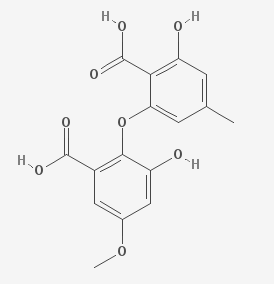
Penicillium is a genus of ascomycetous fungi that is of major importance in the natural environment, in food spoilage, and in food and drug production.

Blue cheese or bleu cheese is cheese made with cultures of the mold Penicillium, giving it spots or veins of the mold throughout the cheese, which can vary in color through various shades of blue and green. This carries a distinct smell, either from that or various specially cultivated bacteria. Some blue cheeses are injected with spores before the curds form, and others have spores mixed in with the curds after they form. Blue cheeses are typically aged in a temperature-controlled environment such as a cave. Blue cheese can be eaten by itself or can be spread, crumbled or melted into or over a range of other foods. Blue cheese is known for its pungent creamy texture.

Ellagic acid is a natural phenol antioxidant found in numerous fruits and vegetables. The antiproliferative and antioxidant properties of ellagic acid have prompted research into its potential health benefits, but it has been identified by the U.S. Food and Drug Administration as a fake cancer cure. Ellagic acid is the dilactone of hexahydroxydiphenic acid.

Penicillium roqueforti is a common saprotrophic fungus in the genus Penicillium. Widespread in nature, it can be isolated from soil, decaying organic matter, and plants.

Mevastatin is a hypolipidemic agent that belongs to the statins class.

Cyclopiazonic acid (CPA) is a toxic fungal secondary metabolite. Chemically, CPA is related to ergoline alkaloids. CPA was originally isolated from Penicillium cyclopium and subsequently from other fungi including Penicillium griseofulvum, Penicillium camemberti, Penicillium commune, Aspergillus flavus, and Aspergillus versicolor. CPA only appears to be toxic in high concentrations. Ingestion of CPA causes one to be an anorexic, to be dehydrated, to lose weight, to be immobile, and has some sign of spasm when near death. They can be found in molds, corns, peanuts, and other fermented products, such as cheese and sausages. Biologically, CPA is a specific inhibitor of SERCA ATPase in intracellular Ca2+ storage sites. CPA inhibits SERCA ATPase by keeping it in one specific confirmation, thus, preventing it from forming another. CPA also binds to SERCA ATPase at the same site as another inhibitor, thapsigargin (TG). In this way, CPA lowers the ability of SERCA ATPase to bind an ATP molecule.

Aristolochene is a bicyclic sesquiterpene produced by certain fungi including the cheese mold Penicillium roqueforti. It is biosynthesized from farnesyl pyrophosphate by aristolochene synthase and is the parent hydrocarbon of a large variety of fungal toxins.

Roquefortine C is a mycotoxin that belongs to a class of naturally occurring 2,5-diketopiperazines produced by various fungi, particularly species from the genus Penicillium. It was first isolated from a strain of Penicillium roqueforti, a species commercially used as a source of proteolytic and lipolytic enzymes during maturation of the blue-veined cheeses, Roquefort, Danish Blue, Stilton and Gorgonzola.

Penicillium chrysogenum is a species of fungus in the genus Penicillium. It is common in temperate and subtropical regions and can be found on salted food products, but it is mostly found in indoor environments, especially in damp or water-damaged buildings. It has been recognised as a species complex that includes P. notatum, P. meleagrinum, and P. cyaneofulvum, but molecular phylogeny established that it is a distinct species and that P. notatum is P. rubens. It has rarely been reported as a cause of human disease. It is the source of several β-lactam antibiotics, most significantly penicillin. Other secondary metabolites of P. chrysogenum include roquefortine C, meleagrin, chrysogine, 6-MSA YWA1/melanin, andrastatin A, fungisporin, secalonic acids, sorbicillin, and PR-toxin.
Penicillopepsin is an enzyme. This enzyme catalyses the following chemical reaction

Barceloneic acid B is a cytotoxic isolate of Penicillium albocoremium.
Penicillium albocoremium is a fungus species in the genus Penicillium growing in Allium cepa.
Medicinal fungi are fungi which contain metabolites or can be induced to produce metabolites through biotechnology to develop prescription drugs. Compounds successfully developed into drugs or are under research include antibiotics, anti-cancer drugs, cholesterol and ergosterol synthesis inhibitors, psychotropic drugs, immunosuppressants and fungicides.
Penicillium carneum is a fungus species of the genus of PenicilliumPenicillium roqueforti var. carneum was reclassified to Penicillium carneumPenicillium carneum was isolated from spoiled meat products, silage, rye bread, water, beer, cheese, mouldy barkers yeast and cork Penicillium carneum produces patulin, penicillic acid, penitrem A, mycophenolic acid roquefortines
Penicillium hordei is a species of the genus of Penicillium which produces corymbiferone and roquefortine C.
Penicillium psychrosexualis is a filamentous fungus in the genus Penicillium. Described as new to science in 2010, the species was found growing on refrigerated moldy apples in the Netherlands. It is closely related to the blue cheese fungus P. roqueforti.
Penicillium paneum is a species of fungus in the genus Penicillium which can spoil cereal grains. Penicillium paneum produces 1-Octen-3-ol and penipanoid A, penipanoid B, penipanoid C, patulin and roquefortine C
Penicillium ribium is a psychrotolerant species of the genus of Penicillium which was isolated from the Rocky Mountains in Wyoming, in the United States. Penicillium ribium produces asperfuran, kojic acid and cycloaspeptide.
Penicillium soppii is a psychrotolerant species of fungus in the genus Penicillium which produces cycloaspeptide A.
Penicillium tulipae is a species of fungus in the genus Penicillium which produces penicillic acid, roquefortine C, roquefortine D, terrestric acid, glandicoline A, glandicoline B, meleagrin, oxaline, penitrem A and epineoxaline.










